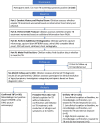Diagnostic Utility and Impact on Clinical Decision Making of Focused Assessment With Sonography for HIV-Associated Tuberculosis in Malawi: A Prospective Cohort Study
- PMID: 32041772
- PMCID: PMC7108937
- DOI: 10.9745/GHSP-D-19-00251
Diagnostic Utility and Impact on Clinical Decision Making of Focused Assessment With Sonography for HIV-Associated Tuberculosis in Malawi: A Prospective Cohort Study
Abstract
Background: The focused assessment with sonography for HIV-associated tuberculosis (TB) (FASH) ultrasound protocol has been increasingly used to help clinicians diagnose TB. We sought to quantify the diagnostic utility of FASH for TB among individuals with HIV in Malawi.
Methods: Between March 2016 and August 2017, 210 adults with HIV who had 2 or more signs and symptoms that were concerning for TB (fever, cough, night sweats, weight loss) were enrolled from a public HIV clinic in Lilongwe, Malawi. The treating clinicians conducted a history, physical exam, FASH protocol, and additional TB evaluation (laboratory diagnostics and chest radiography) on all participants. The clinician made a final treatment decision based on all available information. At the 6-month follow-up visit, we categorized participants based on clinical outcomes and diagnostic tests as having probable/confirmed TB or unlikely TB; association of FASH with probable/confirmed TB was calculated using Fisher's exact tests. The impact of FASH on empiric TB treatment was determined by asking the clinicians prospectively about whether they would start treatment at 2 time points in the baseline visit: (1) after the initial history and physical exam; and (2) after history, physical exam, and FASH protocol.
Results: A total of 181 participants underwent final analysis, of whom 56 were categorized as probable/confirmed TB and 125 were categorized as unlikely TB. The FASH protocol was positive in 71% (40/56) of participants with probable/confirmed TB compared to 24% (30/125) of participants with unlikely TB (odds ratio=7.9, 95% confidence interval=3.9,16.1; P<.001). Among those classified as confirmed/probable TB, FASH increased the likelihood of empiric TB treatment before obtaining any other diagnostic studies from 9% (5/56) to 46% (26/56) at the point-of-care. For those classified as unlikely TB, FASH increased the likelihood of empiric treatment from 2% to 4%.
Conclusion: In the setting of HIV coinfection in Malawi, FASH can be a helpful tool that augments the clinician's ability to make a timely diagnosis of TB.
© Kahn et al.
Conflict of interest statement
None declared.
Figures



References
-
- World Health Organization (WHO). Guidelines for Intensified Tuberculosis Case-Finding and Isoniazid Preventive Therapy for People Living with HIV in Resource-Constrained Settings. Geneva: WHO; 2011. https://apps.who.int/iris/handle/10665/44472. Accessed August 1, 2019.
Publication types
MeSH terms
Substances
Grants and funding
LinkOut - more resources
Full Text Sources
Medical
